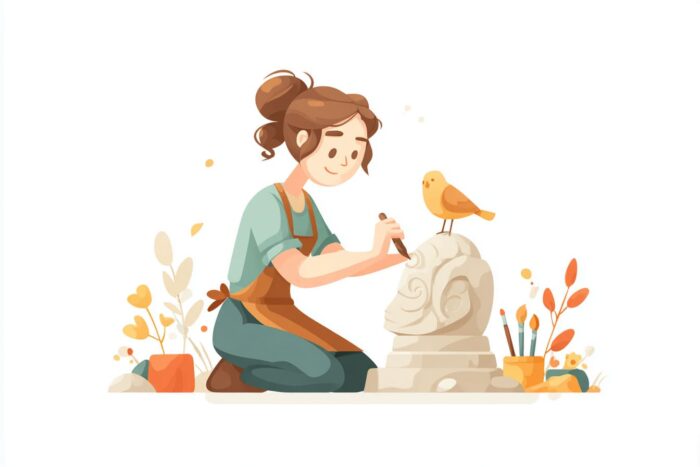In an age where Instagram filters, Photoshop touch-ups, and endless A/B testing shape our sense of “right,” the idea of creating something imperfect can feel radical. What if our mistakes were our greatest asset? By welcoming imperfections, artists—and anyone doing creative work—unlock deeper expression, foster innovation, and connect more authentically with their audience.
The Case for Imperfection
Every stroke that wobbles, every smudge that bleeds outside the lines, tells a story. Neuroscientists have shown that novelty and unpredictability trigger the brain’s reward pathways more powerfully than perfect repetition¹. In art, a tiny irregularity can arrest the viewer’s attention far more than a flawless surface. Imperfection not only humanizes the work—it makes it memorable.
¹ See “Why Our Brains Crave Novelty” in Scientific American: https://www.scientificamerican.com/article/why-our-brains-crave-novelty/
1. From Doodles to Discovery
Doodling isn’t “wasted time”—it’s an incubation chamber for ideas. A 2009 study out of University of Plymouth found that participants who doodled while listening to a monotonous message recalled 29% more information than those who didn’t². Why? The brain’s associative networks light up when you allow your pen to wander, forging unexpected connections that fuel innovation.
- Free-form exploration: Doodles bypass our inner critic.
- Serendipitous breakthroughs: Random lines can hint at new motifs or compositions.
- Low stakes: Mistakes in a margin sketch cost nothing—but they can lead to everything.
² “Doodling May Help You Remember,” Applied Cognitive Psychology, 2009.
2. Flaws as Narrative Devices
In literature, unreliable narrators and plot twists hook readers; in visual art, so do irregularities. A chipped edge on a ceramic vase, or a brushstroke that falters, implies a history, a hidden process. Galleries now showcase “wabi-sabi” exhibitions celebrating Japanese aesthetics of transience and imperfection³. These works aren’t blemished by mistakes—they embody them.
“Wabi-sabi reminds us that the beauty of impermanence and imperfection is central to our human experience.”
— Gavin Van Horn, curator at the Museum of Asian Art
³ Explore “Wabi-sabi: More than an Aesthetic” on The Culture Trip: https://theculturetrip.com/asia/japan/articles/wabi-sabi-more-than-an-aesthetic/
3. The Power of Process Over Product
When we fixate on a polished end result, we sideline the creative journey. Embracing imperfection re-centers our focus on experimentation, iteration, and learning. In software development, the “minimum viable product” (MVP) mindset mirrors this: launch something rough, gather feedback, refine—and let early flaws guide you toward better solutions.
- Iteration as evolution: Each “mistake” informs the next version.
- Resilience through trial: Failing fast enables rapid growth.
- Community collaboration: Sharing work-in-progress invites dialogue and co-creation.

4. Building Authentic Connection
Audiences crave honesty. Instagram posts that reveal behind-the-scenes mishaps drive more engagement than airbrushed glamour shots⁴. When artists showcase their missteps—crooked sketches, discarded drafts—it demystifies creativity and makes their successes feel attainable. Imperfect art becomes a bridge between maker and viewer.
⁴ See “Why People Love Behind-the-Scenes Content” on Social Media Today: https://www.socialmediatoday.com/news/why-people-love-behind-the-scenes-content/
Addressing the Critic: Doesn’t “Good” Still Matter?
Critics of imperfection worry that “anything goes” leads to sloppy work. But embracing flaws isn’t a call to abandon discipline—it’s an invitation to balance craft with spontaneity. The master artist practices scales for years so they can one day “break the rules” convincingly. Technical skill and imperfection aren’t adversaries; they’re collaborators.
- Skill first: Learn fundamentals of drawing, color theory, or composition.
- Permission to play: Once you know the rules, you can choose when to bend them.
- Selective editing: Embrace some mistakes, revise others. The goal isn’t chaos—it’s meaningful choice.
Your Imperfect Creative Challenge
Ready to liberate your inner artist? Try this week’s Doozle prompt:
- Doodle Sprint: Set a timer for five minutes, doodle continuously—no erasing.
- Flaw Highlight: Pick one “mistake” you made—a wobbly line, an odd color mix—and build a tiny composition around it.
- Share & Reflect: Post your transformation on Instagram or Twitter with #DoozleImperfect, and tell us how embracing that flaw sparked a new idea.
Why It Matters
In prioritizing perfection, we risk losing the spark of discovery that fuels innovation across art, design, and even business. By reframing imperfection as an asset, we unlock:
- Deeper creativity: New ideas arise when constraints fall away.
- Resilient growth: Learning from errors accelerates mastery.
- Authentic impact: Viewers connect with the raw, human elements of our work.
Imperfection isn’t a compromise—it’s the canvas on which our most original work is painted. So the next time you hesitate to hit “post,” to sign your painting, or to share that early sketch, remember: your flaws are not flaws at all, but signposts pointing toward your unique creative voice. Embrace them, and let them lead you from doodles to masterpieces.